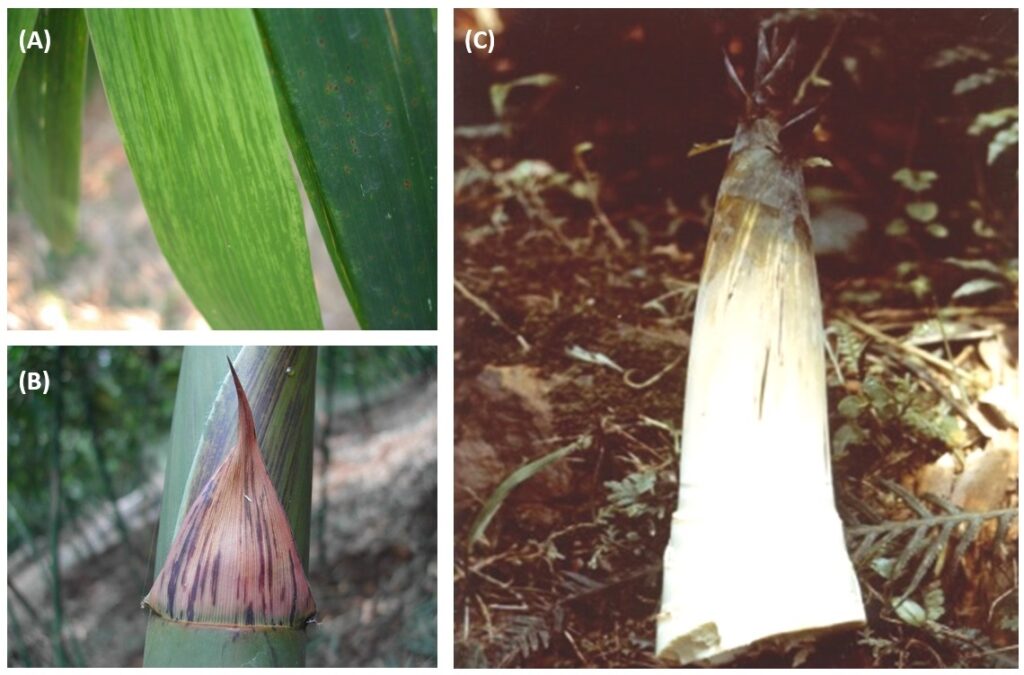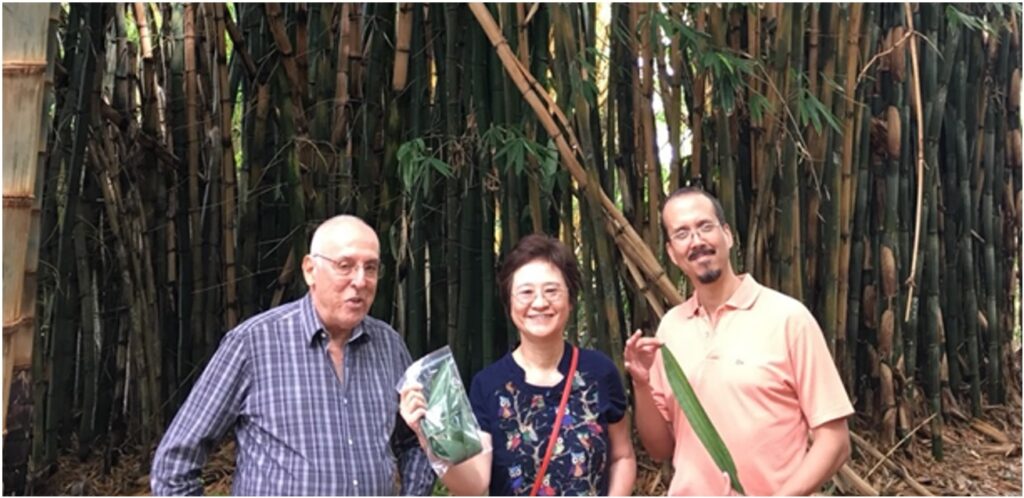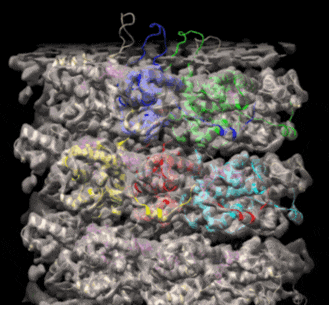
Bamboo, one of the “Four Noble Ones” in Chinese culture, serves various practical applications in our daily lives and holds unique ecological value. Bamboo shoots, cherished for their crisp and refreshing taste, are popular as an essential fiber-rich vegetable in Taiwan, with an annual production value of around US$380 million. Unfortunately, bamboos have been infected with Bamboo mosaic virus (BaMV) for decades in Taiwan. Infected bamboo shoots most certainly develop a rough texture with inferior quality, significantly resulting in nearly a 50% reduction in yield (Figure 1). It has become a limiting factor for bamboo growth and the bamboo industry in Taiwan.

(A) The infected leaves showing mosaic patterns.
(B, C) The brown necrotic stripes on bamboo sheaths (B) and bamboo shoot (C) cause a hard texture in bamboo shoot.
In this interview, we’ll explore the research journey of Dr. Na-Sheng Lin over the recent decades, delving into her integration of fundamental molecular virology with biotechnology. Her work amins not only to uncover the underlying mechanism of BaMV pathogenesis and combat the virus but also to develop virus-based vectors, ultimately benefiting Taiwan’s agriculture and biotechnology.
The BaMV research inspired by family history
Dr. Lin’s father, Mr. Wei-Chih Lin, a distinguished bamboo taxonomist with profound expertise in bamboo cultivation, significantly contributed to her early exposure to the world of bamboo. After completing her master’s degree, Dr. Lin worked as a research assistant at the Taiwan Forestry Research Institute for three years. During this time, she had the opportunity to explore various branches, workstations, and bamboo forests alongside her father and other forestry experts. It was also during these visits, Dr. Lin unexpectedly observed the serious infection caused by BaMV in bamboo. In major bamboo plantations dedicated to bamboo shoot production, the infection rate ranged astonishingly high from 80% to 100% across Taiwan. This observation not only heightened her concern for bamboo production but also became a turning point in her research career, steering her toward the study of BaMV. Throughout the visits to the bamboo fields, she was deeply touched by the respect and gratitude expressed by bamboo farmers and forest experts toward her father’s contributions to bamboo research and production. In that moment, the saying in the textbook, “Science is for the benefit of humanity”, became clear to her.
The complexity and uniqueness of BaMV nature
Dr. Lin was trained in plant virus cell pathology and subsequently pursued molecular virology at the University of Wisconsin in 1990. Due to Taiwan’s unique geographical location, characterized by a tropical and subtropical climate with high humidity and temperature, the region is abundant in various pathogens and pests. Upon returning to Taiwan, Dr. Lin initiated several plant virus research projects. Among them, BaMV received her utmost attention. Not only does it result in significant economic losses in agriculture, but the research on BaMV had been globally neglected since its first report in Brazil in 1977. Dr. Lin was determined to delve into the basic research on BaMV, fighting the battle against it and ultimately translating the ourcomes to benefit Taiwan’s bamboo industry.
During the research, one of the most astonishing findings was the identification of a small RNA molecule associated with BaMV, known as satellite RNA (satBaMV). The satBaMV approximately 840 nucleotides in length, is entirely dependent on BaMV for replication, encapsidation, and efficient movement within plants. Notably, some isolates of satBaMV exhibit interference activity, capable of downregulating the replication of BaMV and consequently attenuating the symptoms induced by BaMV. This finding has unveiled a potential strategy for using satellite RNA to combat BaMV.
To unravel the remarkable features of BaMV and satBaMV, Dr. Lin organized a collaborative research team by inviting experts from National Taiwan University, National Chung Hsing University, and Academia Sinica. Through the collective efforts, they successfully completed whole genome sequencing, determined the RNA terminal structures, examined viral gene expression and regulation, explored viral cytopathology and ecology. In addition, Dr. Lin has extensively visited several countries, including China, Vietnam, Malaysia, India, and the United States to assess the incidence of BaMV. During these trips, she diligently collected infected samples for further analysis over the past few decades. Notably, she was also invited to Brazil, where she obtained samples from bamboo plants initially discovered to be infected with BaMV (Figure 2). Remarkably, these particular bamboo, infected for at least 60 years, serve as valuable material of analyzing RNA progeny. Dr. Lin detected numerous defective RNAs in this aged bamboo, providing ideal material for studying RNA virus recombination and variation.

All these efforts have laid the foundation for comprehending the molecular biology, cell biology and evolutionary phylogeography of the virus and its associated satBaMV. In recent years, the team has also directed its focus toward the ongoing battle between the virus and plants, identifying various plant genes responsible for antiviral functions and revealing how viruses hijack essential host cell genes for their infection. Through the team’s persistent efforts, BaMV has undoubtedly become the most comprehensive virus system within the Potexvirus group. The followings are a few examples of their research on BaMV:
Breaking a 75-year bottleneck by successfully constructing the 3D structure of a flexible plant virus
Filamentous plant viruses can be broadly classified into two categories: rigid (rod-like) and flexible viruses. The rod-like virions can align into a liquid crystalline state, facilitating analysis through X-ray fiber diffraction. On the other hand, flexible viruses, such as BaMV (Figure 3A), cannot be crystallized and are too flexible for high resolution X-ray fiber diffraction. Therefore, despite scientists’ continuous efforts to obtain a 3D model for flexible plant viruses since 1941, it has remained unsuccessful.

(A) Flexible virus particles by negative staining under electron microscopy.
The breakthrough came when Dr. Lin’s research team collaborated with Dr. Edward H. Egelman from the United States, utilizing cryo-electron microscopy (cryo-EM) and his developed software, Iterative Helical Real Space Reconstruction (IHRSR). This collaboration led to the successful resolution of the atomic-level 3D structure of BaMV, a breakthrough published in the journal Nature Structural and Molecular Biology in 2015 (Figure 3B). This accomplishment represents a significant achievement, breaking a 75-year bottleneck in virology. The research not only deepens our understanding of virion assembly, the virus infectious cycle, and structural stability but also establishes a robust foundation for future studies on the interaction with viral RNA and coat proteins and the development of virus-based vectors.

Establishment of a virus-free bamboo regeneration system via meristem culture
Bamboos propagate vegetatively by producing underground rhizomes, giving rise to shoots above the ground. Consequently, the viruses in the infected bamboos are able to transmit from one generation to the next. In addition, bamboos uniquely flower once every few decades at unpredictable intervals. Once it blooms, and then it dies shortly afterwards. To overcome this challenge, the research team collaborated with Dr. Wei-Chin Chang from the Institute of Botany (the predecessor of IPMB) to develop a virus-free bamboo regeneration system via tissue culture. While viruses can systemically infect all tissues of a bamboo plant—roots, rhizomes, culms, sheaths, leaves, and shoots. The team successfully isolated a small portion of virus-free apical meristem and regenerated it into healthy, virus-free seedlings via meristem culture. While the meristem culture requires considerable skill and time, especially for bamboo plants, the team provides a very promising and practical control measure for farmers to control BaMV disease.
In general, no virus vectors are found for Potexviruses in the field. However, in collaboration with Professor Chung-Chi Hu from National Chung Hsing University, the research team identified two dipteran insects in bamboo forests, Gastrozona fasciventris and Atherigona orientalis, that are capable of transmitting BaMV through cutting wounds on bamboo shoots. By validating this transmission pathway, the team has provided farmers with more effective control measures against insect vectors. In combination with the generation of virus-free bamboo seedings, the farmers could control BaMV disease with careful practice in the field.
Utilizing BaMV as a carrier for successful animal vaccine development
The concept of “molecular farming” aims to produce important pharmaceutical and commercially valuable proteins in plants. Plant viruses possess a unique ability to replicate robustly within a host, exhibiting expression levels several to hundreds of times higher than those of typical transgenic plants. Dr. Lin, who collaborated with Professor Yau-Heiu Hsu from National Chung Hsing University and Dr. Shu-Mei Liang from the Agricultural Biotechnology Research Center, developed a BaMV-based vector for functional genomic studies and animal vaccine production. Their initial target was the foot-and-mouth disease virus (FMDV) vaccine for pigs.
Due to the massive foot-and-mouth disease outbreak in Taiwan in 1997, the entire industry suffered losses in the tens of billions of dollars, severely impacting both domestic and export markets for pork. The research team attempted a unique approach by inserting an antigenic fragment of the FMDV protein gene into the genome of BaMV. This modification allowed the structural antigenic peptide of the FMDV to attach to the surface of the BaMV chimeric virus without affecting its infectivity. Thus, the team achieved significant expression levels of the chimeric virus in plants. Notably, this chimeric virus induced protective immunity in swine against FMDV, with the chimeric BaMV expressing the FMDV peptide leading to remarkable neutralization. This breakthrough technology not only resulted in securing intellectual property patents but also facilitated technology transfers. It establishes a solid foundation for utilizing BaMV vectors to produce effective vaccines, medications, and more. This technology allows for the abundant expression of foreign proteins and/or peptide antigens in plants and has successfully produced several vaccines against viral disease affecting livestock and poultry.
Over the course of several decades, Dr. Lin and her research team have consistently devoted their efforts to uncovering the nature of BaMV on the international scientific stage, making it a research subject of significant interest. Their endeavors have not only enhanced international visibility among the scientific community but have also yielded remarkable contributions to the fields of agricultural biotechnology. The dedication and passion exhibited by this team have impressed both local and global immensely. Dr. Lin’s work has undoubtedly reshaped our understanding of BaMV and satBaMV, concurrently exploring the research dimension in both basic science and its application in biotechnology.
To learn more about Dr. Lin, please
Visit IPMB website at https://ipmb.sinica.edu.tw/en/people/ipmb_researchers/lin-na-sheng
